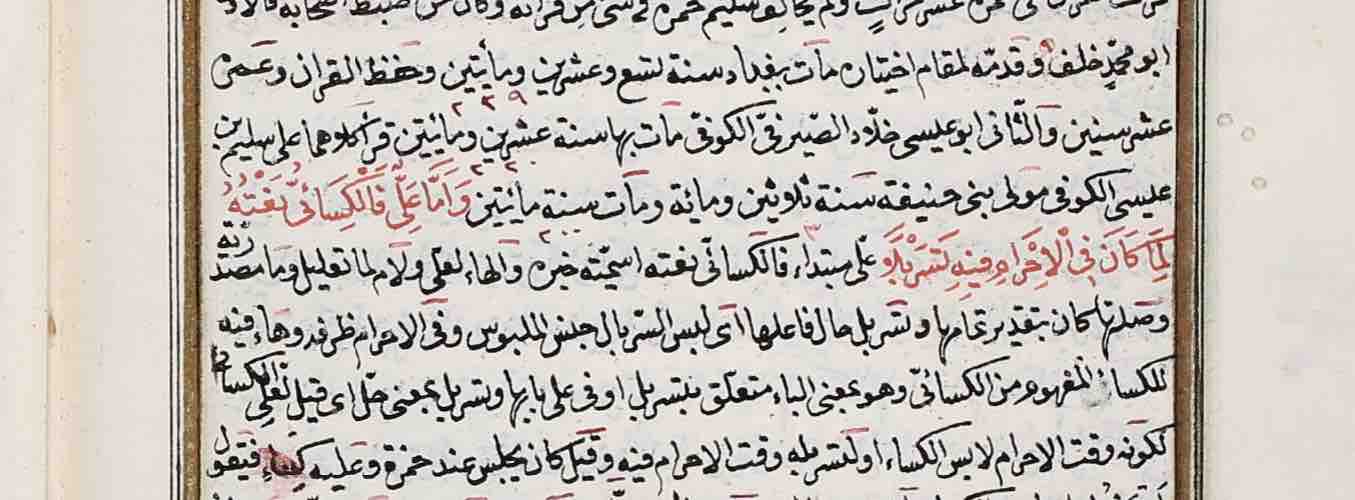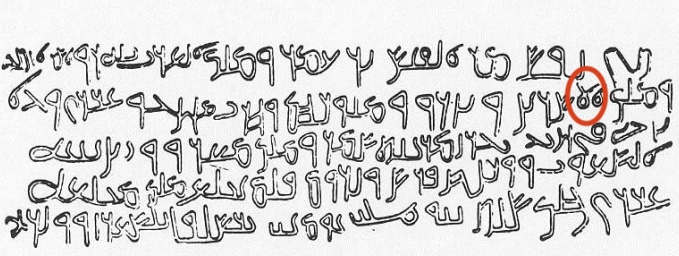Lesson
Arabic Scripts - Basics

Description
The origins and development of the Arabic writing system.
Overview
Arabic manuscripts - whether we mean written in the Arabic language or the Arabic writing system - likely number in the hundreds of thousands, if not more. There are large collections in the Middle East, Europe, North America, and across Asia. Collections of primarily Islamic manuscripts have been more widely known and studied, but there also very important Jewish and Christian collections, even if these are not always written in Arabic script.
Arabic script is an abjad, i.e. a writing system based mostly on the indication of consonants only. It developed from the cursive form of Nabatean Aramaic script (itself known in use from around 100 BCE-350 CE). In Nabatean cursive the letters are connected, as in Arabic. In the Namāra inscription (328 CE) now at the Louvre, one already sees the lām-alif ligature.
 Namāra inscription. Louvre, AO 4083. Louvre Museum [Public domain], via Wikimedia Commons
Namāra inscription. Louvre, AO 4083. Louvre Museum [Public domain], via Wikimedia Commons
 René Dussaud's tracing and reading of the Namāra Inscription, 1905 [Public Domain], via Wikimedia Commons
René Dussaud's tracing and reading of the Namāra Inscription, 1905 [Public Domain], via Wikimedia Commons
Early writing materials include an array of supports, from metal to earthenware to cloth to wood to the shoulder blades of camels. (For an accessible introduction to the genesis of the Arabic script, see Beatrice Gruendler, “Arabic Alphabet: Origin,” in Encyclopedia of Arabic Language and Linguistics, vol. 1, pp. 148-155.)
A number of fragmentary texts, including many on papyrus and parchment, as well as inscriptions both pre- and post-Islamic, survive from the seventh and eighth centuries CE. There we see a style of writing known as ḥiǧāzī, which would be used throughout the lands of Islamic rule, as for example, in a petition dated 718/9 written on leather in Sogdiana (modern Tajikistan and Uzbekistan).
It was from this ḥiǧāzī script that the angular script traditionally called Kufic arose, although it remains to be shown precisely how the two scripts are related. The Kufic script has more recently, following studies by François Déroche, been termed “Abbasid,” the earliest stage being called/ “Early Abbasid.” (For an up-to-date survey of Arabic scripts, including this early history, see Petra M. Sijpesteijn, “Paleography,” in Encyclopedia of Arabic Language and Linguistics, vol. 3, pp. 513–524).
There are fragments of these early scripts written on papyrus (for both documentary and literary texts), parchment, and paper (especially from the ninth century). Entire codices written on these materials do not survive from prior to the early ninth century. The page typically has one column, but two or more columns can be found, especially for poetry. The size of codices varies widely.
Informal hands found in papyri and other documents are naturally more idiosyncratic, and the term "chirodictic" has been suggested to replace “cursive,” since Arabic script is essentially cursive. By the ninth century, Early Arabic manuscripts (both Islamic and Christian) are written in an angular variety of scripts traditionally called Kufic, more recently described as "Abbasid bookhand" for the earliest period and then "New Abbasid" for the later. In the tenth century, the Naskh script appears and, with eventual regional variation, proves very popular as a bookhand. A host of other script-types can be distinguished, varying with the content of what was being copied and where and when it was copied, and even in what language. Copyists of Turkish and Persian manuscripts, for example, sometimes used script-types distinct from those commonly found for Arabic-language manuscripts. Almost every location along a spectrum of presence or absence of vowels and diacritics will have a witness in some manuscript or other: some copyists used such marks profusely, others very rarely.
Arabic-language manuscripts have been written not only in the Arabic writing system, but also in Hebrew and Syriac letters (known as Judeo-Arabic and Garšūnī, respectively), as well as some other scripts, including Greek and Armenian.
Because there are other many opportunities available for studying Arabic paleography using Islamic materials (e.g. Jan Just Witkam’s Course in Islamic Paleography), these lessons will be based on Christian Arabic manuscripts. They begin with the hands used in the earliest extant Christian Arabic manuscripts, from Saint Catherine’s Monastery, Sinai. The Library of Congress has generously shared scans of microfilms from their pioneering microfilming project (undertaken in 1949!). These manuscripts go back to the ninth and tenth centuries.
Then we will turn to manuscripts available at HMML. The script-type most frequently encountered in these manuscripts is Naskh, one of the easiest Arabic script-types to read. Naskh appeared during the late 10th-early 11th century, and was used by various Arabic-script communities both Muslim and Christian. In addition to Naskh, we will see a few examples of Ruqʿa, which appears from the 18th century, especially in manuscripts (and archives) that were considered more commonplace. Ruqʿa can be more difficult to read than Naskh.
In addition to the letterforms proper, we will give some attention to diacritic marks, including vowels, when they are present in the selected manuscripts.
For reference, the names of the Arabic letters are:
| alif | ṯāʾ | ḫāʾ | rāʾ | šīn | ṭāʾ | ġayn |
| kāf | nūn | wāw | bāʾ | ǧīm | dāl | zāy |
| ṣād | ẓāʾ | fāʾ | lām | hāʾ | yāʾ | tāʾ |
| ḥāʾ | ḏāl | sīn | ḍād | ʿayn | qāf | mīm |
As with any paleographic exercise, the more you know the language, the more smoothly reading various hands goes. Arabic is no different. Whatever the hand is like, however easy or hard to read, the text should make sense. If you think a letterform seems to be what it should not be, resulting in an impossible expression, you are probably misreading it. Yes, there can be mistakes (as we will see!); yes, people who write can misspell or leave words out, etc. In general, however, the fuller your knowledge of morphology and syntax, the more smoothly you will follow the letters and words a scribe has written. Doing paleography well requires knowing the language well.
For convenience, the manuscripts presented in these lessons are divided roughly by chronology as follows:
- 9th-10th centuries (Sinai manuscripts)
- 11th-13th centuries
- 14th-16th centuries
- 17th-18th centuries
- 19th-20th centuries
Because Naskh is one of the easiest script-types to read, close to the typefaces readers know from printed books, there will be little to say about many of the letter-forms in these manuscripts. For each page presented, we offer some remarks on the general character of the script, especially noting characteristic letter-shapes and other features of the scribe’s way of presenting the text. Arabic script is a very flexible writing system, as we will see.
Select Bibliography
- Abbot, Nabia (1941). Arabic Paleography. Ars Islamica, 8, 65–104.
- Assfalg, Julius (1991a). Écriture arabe. In P. Krüger & J. Assfalg (Eds.), Petit dictionnaire de l’orient chrétien (pp. 147–148). Turnhout: Brepols.
- Assfalg, Julius (1991b). Manuscrits arabes chrétiens. In P. Krüger & J. Assfalg (Eds.), Petit dictionnaire de l’orient chrétien (pp. 356–357). Turnhout: Brepols.
- Boogert, Nico van den. (1989). Some Notes on Maghribi Script. Manuscripts of the Middle East, 4, 30–43.
- Déroche, François (1998). Les études de paléographie des écritures livresques arabes: Quelques observations. Al-Qantara, 19, 365–381.
- Déroche, François (2000). Manuel de codicologie des manuscrits en écriture arabe. Paris: Bibliothèque Nationale de France.
- Déroche, François (2001). L’écriture arabe. In A.-M. Christin (Ed.), Histoire de l’écriture. De l’idéogramme au multimédia (pp. 218–227). Paris: Flammarion.
- Déroche, François (2004). Le livre manuscrit arabe: Préludes à une histoire. Paris: Bibliothèque Nationale de France.
- Endress, Gerhard (1982a). Die arabische Schrift. In W. Fischer (Ed.), Grundriss der arabischen Philologie. I. Sprachwissenschaft (pp. 165–209). Wiesbaden: Ludwig Reichert.
- Endress, Gerhard (1982b). Handschriftenkunde. In W. Fischer (Ed.), Grundriss der arabischen Philologie. I. Sprachwissenschaft (pp. 271–296, 306–315). Wiesbaden: Ludwig Reichert.
- Fort, Jean-Louis (2012). Marginalia arabica dans les codices chenoutiens du monastère Blanc: inventaire et premier essai d’interprétation. In J. P. Monferrer, H. Teule, & S. Torallas (Eds.), Eastern Christians and their Written Heritage. Manuscripts, Scribes and Context (pp. 77–113). Leuven: Peeters.
- Gacek, Adam (2001). The Arabic Manuscript Tradition: A Glossary of Technical Terms and Bibliography. Leiden, Boston, and Köln: Brill.
- George, Alain (2007). The Geometry of Early Islamic Calligraphy. University of Oxford.
- Gori, Alessandro (2007). Arabic Manuscripts. Encyclopaedia Aethiopica (Vol. 3, pp. 744–749).
- Grohmann, Adolf (1967). Arabische Paläographie. Vienna: Hermann Böhlaus.
- Gruendler, Beatrice (1993). The Development of the Arabic Scripts. Atlanta: Scholars Press.
- Gruendler, Beatrice (2006). Arabic Alphabet: Origin. In K. Versteegh (Ed.), Encyclopedia of Arabic Language and Linguistics (Vol. 1, pp. 148–165). Leiden, Boston: Brill.
- James, David Louis (1992). The Master Scribes: Qurʾans of the 10th to 14th Centuries A.D. Oxford: Nour Foundation in association with Azimuth Editions and Oxford University Press.
- Khan, Geoffrey (1992). Arabic Papyri, Selected Material from the Khalili Collection. Oxford: Nour Foundation in association with Azimuth Editions and Oxford University Press.
- Majidi, Mohammed-Reza (2006). Einführung in die arabisch-persische Schrift (3rd ed.). Hamburg: Helmut Buske.
- Mitchell, T.F. (1970). Writing Arabic: A Practical Introduction to the Ruqʿah Script. London: Oxford University Press.
- Moritz, Berhard (1905). Arabic Palaeography: A Collection of Arabic Texts from the First Century of the Hidjra till the Year 1000. Cairo: Khedival Library.
- Pataridze, Tamara (2012). Les signatures des cahiers unilingues et bilingues dans les manuscrits sinaïtiques (georgiens, arabes et syriaques). Manuscripta Orientalia: International Journal for Oriental Manuscript Research, 18, 15–35.
- Robin, Christian (2006). La réforme de l’écriture arabe à l’époque du califat médinois. Mélanges de l’Univeristé Saint-Joseph, 59, 319–364.
- Sijpesteijn, Petra M. (2008). Paleography. In K. Versteegh (Ed.), Encyclopedia of Arabic Language and Linguistics (Vol. 3, pp. 513–524). Leiden, Boston: Brill.
- Sijpesteijn, Petra M. (2009). Arabic Papyrology and Islamic Egypt. The Oxford Handbook of Papyrology (pp. 452–472). Oxford: Oxford University Press.
- Sourdel-Thomine, Janine. (1978). Khaṭṭ. Encyclopaedia of Islam (Vol. 4, pp. 1113–1120). Leiden: Brill.
For earlier presentations of Arabic manuscripts, see:
-
- William Wright, Facsimiles of Manuscripts and Inscriptions, Oriental Series (London: Palaeographical Society, 1875-1883). In addition to some Islamic materials, there are some Christian texts. See № 21, 76, 95, and 97.
- “Manuscriptorum specimina” in L. Cheikho’s Chrestomathia Arabica cum lexico variisque notis (Beirut, 1897), which is the continuation of the Elementa grammaticae Arabicae of P. Durand and Cheikho (Beirut, 1896). pp. 401-410 (eight examples, including other than Naskh)
- Agnes Smith Lewis and Margaret Dunlop Gibson, Forty-one Facsimiles of Dated Christian Arabic Manuscripts with Text and English Translation, with Introductory Observations on Arabic Calligraphy by David S. Margoliouth, Studia Sinaitica 12 (Cambridge, 1907).
- E. Tisserant’s Specimena codicum orientalium (Bonn, 1914) only gives Qurʾān fragments, nothing Christian.
- A.J. Arberry, Specimens of Arabic and Persian Palaeography. London, India Office, 1939.